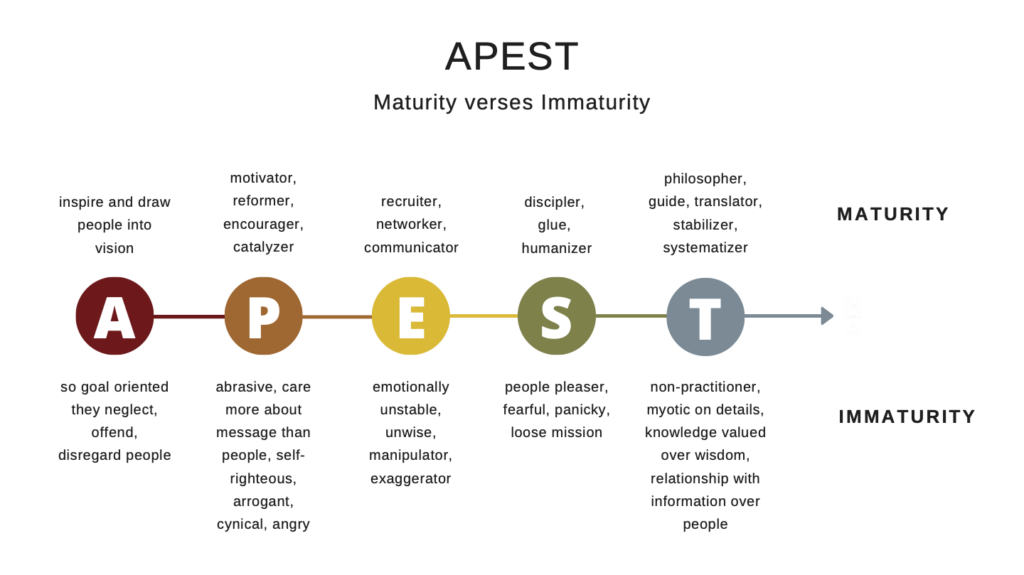By Brian Scott
Today’s article is the fourth in a series of five articles describing the one leadership gift expressed in diversity through APEST, “A”postolic, “P”rophetic, “E”vangelistic, “S”hepherd, “T”eacher, found in Ephesians 4. The shepherd or pastoral function has been expressed in some form throughout history. There are examples and admonitions in Scripture of what it means to shepherd well and how disastrous it becomes when it is not done well.
Here is how Alan Hirsch and Dwight Smith see the Shepherd function.
Shepherd function
Hirsch – Humanizer, Carer, Social cement/glue
Smith – (Shepherd’s) nurture the gospel’s truths in the church, reflect God’s heart for peoples’ pain
The title “Pastor or Shepherd” has been automatically given to those who hold leadership positions within the local church. This can become confusing to leaders and disciples when teaching on the diversity within the gift of leadership. Calling someone a pastor when they carry another function can place a lot of expectations on a leader that will be unattainable.
The actual functioning of the shepherd, in context with the equipping of disciples, is to keep us caring and nurturing the community of believers. They bring an aspect of bond and connection within the household of the Father that is strengthened by how we minister to one another. This function teaches us to be accessible to people, especially when there is a need that arises in peoples’ lives. They themselves will be seen coming alongside people in their experiences. Sympathy and empathy are characteristics of their interactions with people who are in places of difficulty. The shepherd places high priority on their availability to people, therefore, their calendars are full of personal connections.
The benefit of the shepherd is seen in many ways within the body. Especially in unilateral settings, the culture of the church will reflect the strengths and characteristics of the main leader. Churches who have hierarchical structures led by a shepherd functioning leader are extremely welcoming. They will understand how to care and support one another. If the shepherd administrates well, they will develop programs that meet the needs of the peoples’ physical, emotional, and spiritual conditions. Terms such as “family,” “vulnerability,” and “intimacy” will be used as values. At the same time, the community will be guarded and protective of the church and those who are considered part of the family.
Shepherds will want to be aware of every situation or circumstance the individuals of the church are facing and will want to have influence or voice into resolving any pain or difficulty they experience. They take very seriously the idea that the “flock” is to be guarded and protected. When the church has allowed the shepherd to take the primary role for caring, nurturing and protecting the body, it takes a toll physically and emotionally. There is never a shortage of people who are needing care, and this becomes too much of a weight for one person to carry. In the hill illustration, the shepherd holds fast to the idea that there should always be a sanctuary or hospital for people to enter to be cared for. If there is a hill to conquer, a path to take, people to reach, then there must be a hospital on wheels to move along on the journey.
Shepherds and teachers, who will be addressed in the next article, dominate the landscape of ministry leadership positions within the church in the West. In unilateral leadership structures, the shepherd function will be prone to redirect focus on the ongoing concern of the institution losing a missional emphasis. There is already a tendency in most post-Christian settings to be lulled into the comfort and individualized elements of the gospel message. Discouragement, depression, and division can manifest itself in the body of the church if God’s mission is lost in the culture. Life becomes centered on the programs and activity within the church walls.
For those who hold the title of “Pastor” yet carry a different function of APEST, there is great angst in their life based the expectations of those they serve, the expectations they place on themselves, as well as the expectations of others who serve in the same profession. To alleviate this burden, many experts have advised leaders to delegate. Delegating activities is a good practice, but a leader can eliminate the influence of another gift or function, i.e., shepherd function, by disconnecting to avoid situations that are uncomfortable. The shepherd function is there to equip all of us, including other functions around a leadership table, to care for the body.
The Apostolic leader can push a Shepherd to places they aren’t ready to go. In unhealth, the Shepherd is rarely ready to move so they will dig their heals in refusing to see the benefit of exploration. They may express the fact that the body is not in a healthy enough place to be innovative. The Prophetic function usually feels harsh to the Shepherd. They often see the need to protect the body from the Prophet. The Evangelistic leader desires to see the lost found and can become irritated with the lack of concern for the lost in church leadership. The Shepherd will not verbalize prioritizing the gathering over evangelism, but they often demonstrate it with a lack of equipping the body to reach their neighborhoods.
The Shepherd function is desperately needed to speak into the vision of the church. Below are questions that can help utilize the Shepherding function in effective ways.
- Can you identify the Shepherd function around your leadership table?
- Does that leader operate as a Shepherd who equips the body to care for one another? Or does the body depend on that leader to fulfill the majority of the care ministry solely by themselves?
- What areas of care need to be strengthened in your church? How can you utilize the Shepherd function to equip others to meet those needs?
